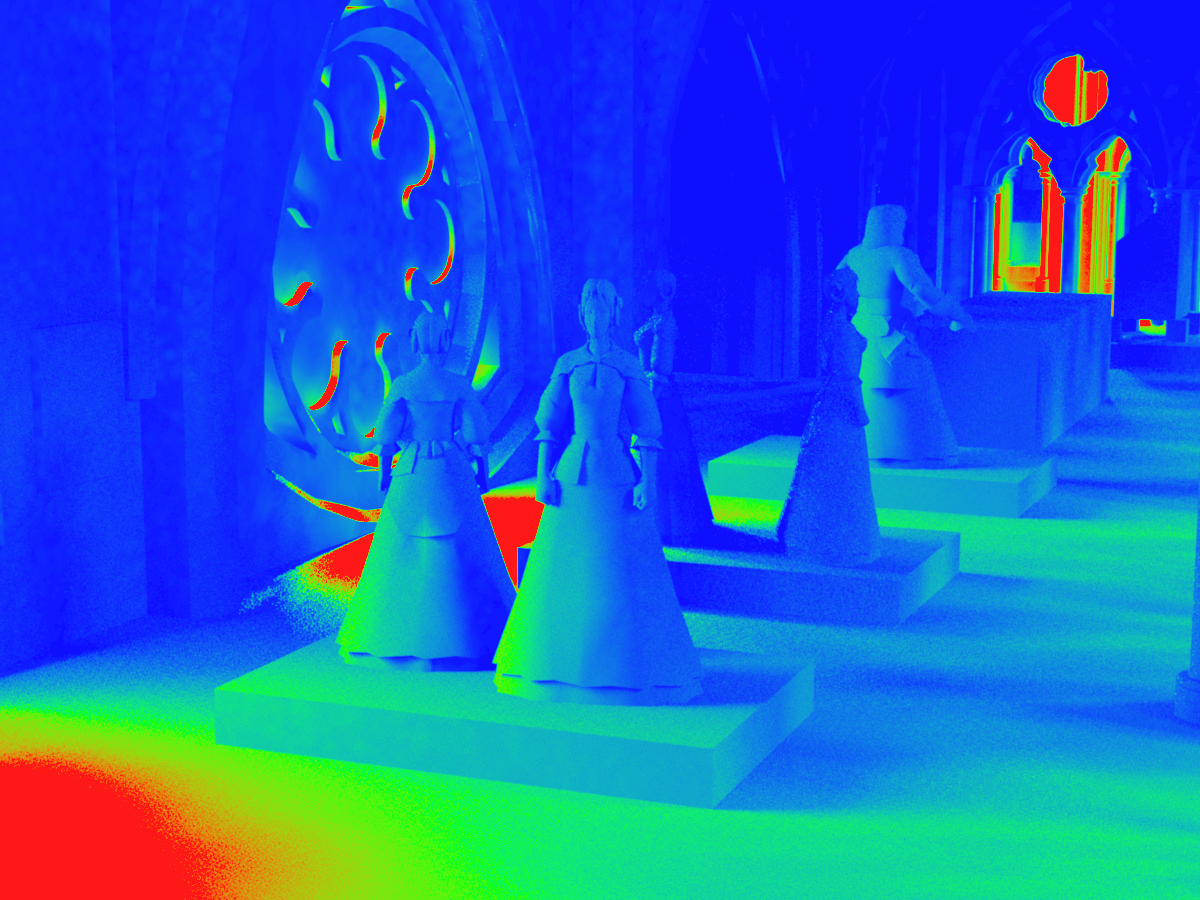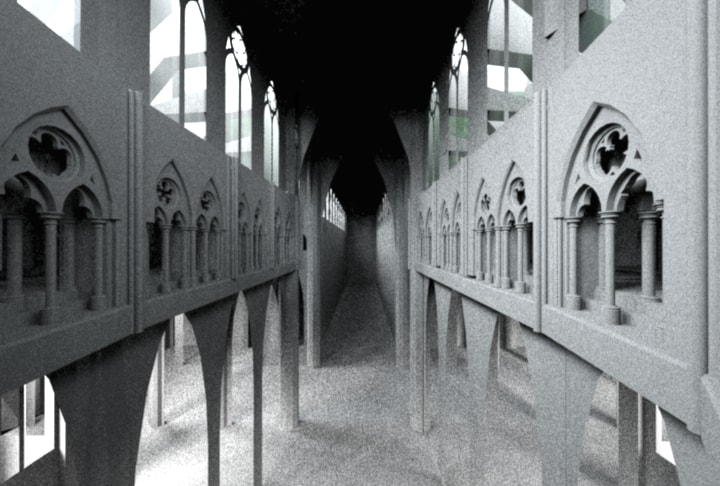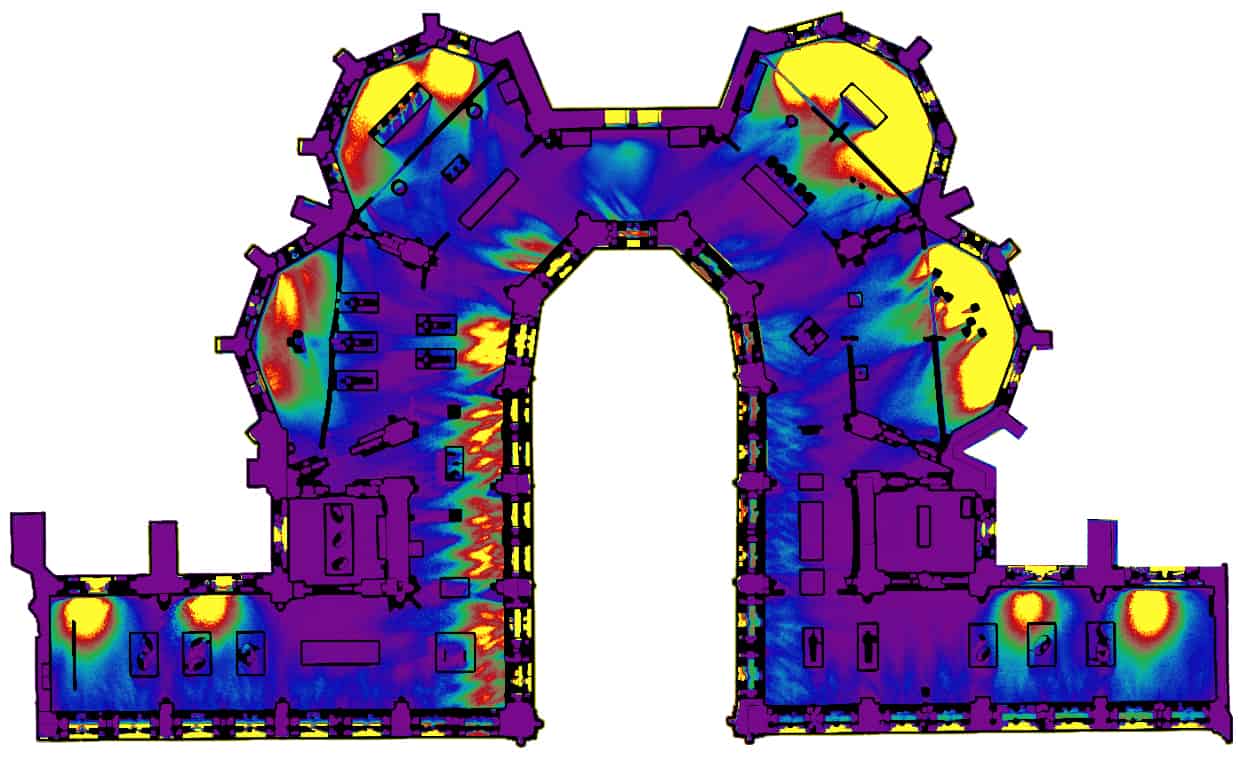Max Fordham’s work represents an apparently rare example of an engineering study being used directly to inform an architectural design, rather than the engineering following on from and making possible the architecture. The lighting conditions inside the gallery were absolutely crucial, as they both make sure that the objects on display are visible to the best possible effect and also have to be carefully considered to ensure that exposure to light whether natural or artificial – does not damage the artefacts. Many of the exhibits are delicate fabrics and works on paper, which are very easily damaged by light, and some of the robes contain red pigments which are also susceptible to fading in sunlight.

Chasing sunbeams
Previous studies carried out by the National Gallery have proved that instantaneous bright light is not in fact as damaging to pigments as was once thought, but cumulative damage can be catastrophic. The team therefore used a laser scanner to model every surface inside the Abbey, and every light source – from the direct sunlight coming in through the windows, to the ambient light coming through the open sides of the gallery’s internal walls from the nave – and then used data from Heathrow Airport (where readings are regularly taken of the intensity and direction of sunlight) to model how light enters and moves through the volume of the gallery space across every day of a typical year. From these models, they could identify the points in the gallery which receive the most intense sunlight and where items whose pigments would be susceptible to fading should be kept away from. In one instance, they recommended that an effigy (Queen Anne) should be rotated slightly to make sure none of her robes were in a dangerous position. Some of the windows in the outside wall of the Abbey had special UV filtering film applied to their inner faces, to remove the most damaging wavelengths.

These digital models also helped MUMA and the exhibition lighting specialists DHA to determine where extra lighting might be needed. Throughout the gallery, careful spotlighting picks out details of the architecture as well as highlighting certain exhibits.
Keeping the gallery open on its internal side was an important part of the design. But this brought the gallery’s designers into direct conflict with the original philosophy of the Abbey’s 13th century designers. Gothic architecture – of which the Abbey’s English Perpendicular style is a variant – is specifically intended to make church interiors as light as possible, with the flying buttresses that characterise the exterior of the building helping to support the roof, so that the walls are relieved of a great deal of their load and can be pierced with huge spaces for windows.
This means that the whole interior of the building is flooded with natural light, and with the open sides of the triforium gallery it also streams in here: a real danger to the pigments in the exhibits. To protect them from this light when the gallery is empty, blinds can be drawn down across the open space between the ceiling and the safety railing. These blinds are also drawn for a short while after opening hours in the summer months, to protect against low-angled morning light, but are kept open as much as possible to preserve the atmosphere of the Abbey. The exhibits are positioned so this light does not strike them. This was an essential part of the deliberate design feature of making the gallery feel like part of the church rather than a separate museum, explained Max Fordham’s head of Light+Air, Nick Cramp. “These objects are part of the Abbey’s history, and it makes sense that the space they are shown in is, and feels like, part of the Abbey,” he explained.

Seasons in the sun
The environmental control in the gallery was potentially a difficult problem, again because the gallery is an open space and its airflow is part of the atmosphere of the whole enormous and complex-shaped building. It was therefore not possible to install air conditioning units, and in any case, these and the ducting needed to operate air conditioning would have been obtrusive. “The Abbey actually helped us here,” said senior partner Mark Nutley. “It’s an enormous thermal mass so its internal temperature is actually fairly stable throughout the year, regardless of the weather. Also, the huge windows on either side are very old and they are not entirely airtight, and that gives us a small boost of natural ventilation.” With summer’s heat taken care of, heating for the winter months was installed below a new oak floor installed over the retained and strengthened Wren structure, and the laser cut blackened steel vents through which warmed air is directed into the gallery are pierced with holes in an eight-pointed star shape that echoes the plan of the Weston Tower (see below), a motif which occurs in several other places throughout the gallery in an almost subliminal way - but rewarding for the type of visitor who notices these details, your reporter included.
Throughout the gallery, great care had to be taken to ensure that every historical feature of the space was preserved and the difference between old and new structures was clear. Although the new floor is oak, there is no mistaking it for the 500-year-old Wren beams that criss-cross the space. Even some Victorian cast-iron reinforcements were left in place and conserved, although they are not visible. “There’s almost always metal in masonry, no matter how old it is, and it often causes problems,” Sam Price said.




Nanogenerator consumes CO2 to generate electricity
Whoopee, they've solved how to keep a light on but not a lot else.